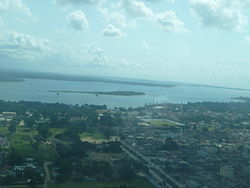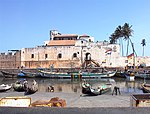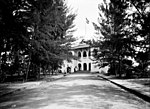Port Graham
Port Graham
Nhare | |
|---|---|
City | |
 | |
| Motto(s): | |
| Country | File:RwizikuruFlag.PNG Rwizikuru |
| Province | Manathea |
| Founded | 1638 |
| Government | |
| • Mayor | Mavhu Mushohwe |
| Population (2011) | |
| • City | 571,937 |
| • Rank | 4th in Rwizikuru |
| • Urban | 571,937 |
| • Metro | 612,252 |
| Time zone | UTC+3:45 (Rwizikuran Standard Time) |
| • Summer (DST) | UTC+3:45 (not observed) |
Port Graham is the fourth largest city of Rwizikuru. Established in 1638, it is the oldest Estmerish settlement in present-day Rwizikuru, and served as a centre for the slave trade from Bahia to Estmere and her colonies across the world until slavery's abolition in the 1740s. Following this, the area went into decline, with Port Graham ceasing to be capital of Riziland when Estmere left the area in 1803. When Estmere returned in the late nineteenth century, it was supplanted by Port Fitzhubert as the capital of Riziland.
It is today the primary economic centre of western Rwizikuru, and is one of the main economic centres of the country alongside Port Fitzhubert on the coast, with the 2011 census reporting that the Port Graham metropolitan area is the second largest in Rwizikuru after that of Port Fitzhubert.
Etymology
The name Port Graham derives from Captain Reynold Graham, and was initially known as Fort Graham. However, due to its location along the Rwizikuran coast, the community growing up along the fort became informally known as Port Graham, while the fort itself kept the name of Fort Graham. Thus, in 1869, it was officially renamed by the Estmerish colonisers as Port Graham.
The Rwizi name, Nhare derives from the Rwizi word for fortress, "nhare," referring to Fort Graham. In the 1960s, it was suggested to rename Port Graham to Nhare, but Izibongo Ngonidzashe vetoed the idea, as he believed that "it is inappropriate for cities founded by Eucleans to lose their Euclean names. However, in 1965, he allowed Nhare to be used alongside Port Graham.
However, Nhare was not always the Rwizi name: when Estmere first established Fort Graham, Reynold Graham recorded the name as Seesheshee, which is believed to be a corruption of Zvisheshi, which in turn is a contraction of the Rwizi phrase zvishoma chiteshi, meaning "little harbour."
History
Pre-slave trade
The site of what is now Port Graham has been continuously inhabited since 650 BCE. As it is situated on the mouth of the Mutezo River, the settlement, while not as important as Munzwa or Guta reMabwe (present-day Chekumabvazuva), was an important settlement.
The settlement was believed to have been visited by Don Pilote in the 1330s, as Pilote had reported that the settlement was "a welcoming gateway," and noted the high quality of the roads between it and the capital of the Rwizi Empire in Munzwa.
Slave trade

In 1638, Estmere negotiated an agreement with the Aguda Empire, to establish Fort Graham as a trade post.
With its establishment, it quickly became the most important trading post, as slaves were sold to the Estmerish at Fort Graham, in exchange for Euclean goods, such as guns and books. As well, Fort Graham became the main administrative centre for Estmere's other trade posts, as Estmere negotiated with Bahian chiefs to establish trade posts, especially following the collapse of the Rwizi Empire in the 1650s, and the receding power of the Aguda Empire: in its wake, Munaki Mutezo and his descendants would come to govern the surrounding area.
Thus, by 1680, Fort Graham was seen as the main centre of power, as the local overseers of the trade posts were based there, with the surrounding community becoming one of the largest cities following the fall of Munzwa. This helped enrich the Mutezo family, which governed the Bahian inhabitants, but at the same time forced the Mutezos to engage in wars to take more slaves to trade to the Estmerish, as demand for slaves increased, especially in the Asterias.
However, with the Gilded Wars, Estmerish influence started declining, as the forts were taken over either by Gaullica, or else were taken over by other native tribes, resulting in Fort Graham being the only fort remaining under Estmerish control by 1721. This helped increase its status, as by this point, virtually all slaves from Rwizikuru sent to Kingsport came through Fort Graham.
This would come to a halt in the 1740s, when Estmere abolished slavery and the slave trade: all of a sudden, trade at Fort Graham ceased to be profitable, as there was suddenly no resource from the region that could replace slaves. While over the next few decades, explorers tried to find resources to replace slaves, such as minerals, or wood, by 1803, the officials concluded that "there is no real value in maintaining a fort when the only resources that this corner of Bahia has to offer are the people." Thus, they abandoned Fort Graham.
Nineteenth century
With the departure of Estmere from present-day Port Graham, the Mutezo family now had nominal control over the area, and they took over Fort Graham. However, the end of slavery meant that their main source of wealth had dried up, which greatly weakened the Masimbe system used not by the Mutezos, but also all other rulers within the general region.
During this time, the power of the Mutezo family diminished, as the village system became more prominent among the communities surrounding present-day Port Graham. By the 1840s, it was believed that the Mutezo family only had real control over Fort Graham and its immediate environs, with local chiefs having displaced the Mutezo family outside this immediate area.
The Mutezo family maintained control over Port Graham until 1868, when Charles Fitzhubert and his army retook control of Fort Graham after a pitched battle against the Mutezo family.
Colonial rule
With the reconquest of Port Graham, some officials in Estmere sought to move the capital from Port Fitzhubert to Port Graham, as Port Graham was seen as more central compared to Port Fitzhubert, and as it had served as the main Estmerish centre of power during the slave trade. However, Charles Fitzhubert was unwilling to move the capital away from Port Fitzhubert, as Fitzhubert argued that the Mutezo River was not as navigable as the Rwizikuru River, which meant that they would not be able to get as far inland as they otherwise would.
Despite this decision, the colonial authorities did not neglect Port Graham altogether, as its position at the mouth of the Mutezo River meant it was well-suited to development.
Thus, Richard Fitzgerald was commissioned to design a "new city" on the western bank of the Mutezo River, as opposed to the old city on the eastern bank, with Fitzgerald deciding on a gridiron plan of five avenues going north to south, and ten streets going east to west, with a central square in the middle of Port Graham, much like Port Fitzhubert.
By 1871, Port Graham was reported to have 1,209 inhabitants, with only sixteen white people, with the remainder being Bahian. During the 1870s, the town developed a "modern harbour," and became one of the main commercial centres of Riziland, second only to Port Fitzhubert. This meant that by 1881, it had 6,503 people, including thirty whites, and eleven Mirites.
By 1891, Port Graham had reached 11,496 people, which meant that in 1893, it was granted city status, making it the second settlement in Riziland to be granted city status after the capital city, Port Fitzhubert. While the city council was only comprised of white people, it was seen as a sign of "advancing civilisation" within Bahia.
In 1901, Port Graham had a population of 15,697 people, which grew to 16,493 in 1911. However, with the economic crisis in 1915, Port Graham's population growth slowed, while exports going through Port Graham slowed down, with the lack of demand in Estmere and her colonies. Thus, in 1921, the population fell to 15,968 people.
During the Great War, Port Graham was fortified as it was felt that Gaullican troops from Quigomba would want to take control of Port Graham, as it was the western railhead. This meant that the population grew as many colonial troops moved to Port Graham, with the 1931 census reporting 21,496 people.
Following the end of the Great War, Port Graham's role was eclipsed by Port Vaugeois (present-day Port Tsalar, Mabifia) as the primary economic centre of western Rwizikuru, especially following the extension of the railway to Port Vaugeois from Port Tsalar in the late 1930s and early 1940s. At the same time, Port Graham became a centre for nationalist agitation led by the Rwizikuran National Movement, as it was felt that Port Graham had sacrificed a lot for Estmere, and received little in return.
By 1941, Port Graham's population was at 48,494 people, including 2,509 Mirites and 506 whites.
Post-independence
Following Rwizikuru's independence from Estmere in December 1946, Port Graham continued to see its role diminish in favour of Port Vaugeois, as Port Vaugeois had a larger population, was connected to the rest of Rwizikuru, and the rest of the world.
By 1951, the population of Port Graham was at 45,598 people, with the population loss primarily attributed to migration towards either Port Vaugeois, Port Fitzhubert, or Sainte-Germaine (present-day Mambiza, Garambura), while the white population in Port Graham almost all left for Estmere.
In the 1950s, Port Graham's economic fortunes were slightly improved by the construction of the Mugwagwa, or the motorway, which was to connect Port Vaugeois to Port Fitzhubert via Port Graham. This helped improve Port Graham's economic situation, as it was now situated on a major motorway, which enabled more people to travel to Port Graham, even if they were only passing through it en route to Port Vaugeois or to Port Fitzhubert.
By 1961, Port Graham's population had risen to 52,595 people, but during the 1960s, the economic situation of Port Graham deteriorated, especially as President Izibongo Ngonidzashe instituted policies which deterred foreign investment into the country and expelled the Mirites in 1966.
However, following the conclusion of the Mabifian-Rwizikuran War in 1969, Port Graham's status rapidly improved as many refugees fleeing the conflict moved to Port Graham, while the loss of Port Vaugeois to Mabifia meant that Port Graham was once again the primary economic centre. Thus, in 1971, the population tripled to 157,803 people, with the bulk of the growth coming from refugees from Yekumavirira.
During the 1970s, Port Graham, while now an economic centre for western Rwizikuru once more, did not fare as well due to the isolationist nature of Izibongo Ngonidzashe's regime, and the fact that trade between Rwizikuru and the rest of the world was severely restricted. Economic growth would only really commence in the late 1970s and early 1980s when Izibongo's son and successor, Kupakwashe Ngonidzashe assumed the throne in 1979. By 1981, the population rose to 173,982 people.
During the 1980s, as the Mirites were allowed to return to Rwizikuru, and the economy was opened up and liberalised by Mambo Kupakwashe Ngonidzashe, Port Graham saw substantial economic growth, and population growth as many from the rural areas in western Rwizikuru flocked to Port Graham. This helped feed a virtuous cycle, as continued economic growth attracted more people, which in turn increased economic growth.
However, this growth came at a cost, as the infrastructure, which had already been bursting at the seams since the end of the Mabifian-Rwizikuran War in 1969 could not cope with the increased demand. This meant increased traffic congestion, the rise of shantytowns, poor sewage treatment, and unreliable electricity.
Contemporary era
By 1991, the population of Port Graham had roughly doubled to 347,173 people. During the 1990s, Port Graham's growth continued, although at this point in time, the city started to improve, with investments by city council helping reduce the number of households who lacked access to water from 46.7% in 1990 to 24.6% in 2000, while electricity became more reliable.
These achievements were remarkable, as in 2001, the population of Port Graham rose to 497,016 people. In the 2000s, Port Graham continued their efforts of tackling their challenges, with the institution of a modern public transit system in 2002, the opening of a sewage treatment plant in 2005, and the connection of 92.5% of households to water and sewage by 2006. The shantytowns started to be replaced with neighbourhoods with more robust houses, especially those near the city centre and the old town, although continued migration has continued to create more shantytowns.
As of the 2011 census, the population of Port Graham reached 571,937 people, which made it the fourth largest city in Rwizikuru, and the second largest metropolitan area in Rwizikuru.
Geography
Port Graham is situated on the mouth of the Mutezo River, where it exits into the Maccan Sea. It is flat and low-lying, and is divided by the Mutezo River. While Fort Graham and the oldest buildings are situated on the eastern side of the Mutezo River, the main commercial district is situated on the western side of the river.
Climatically, Port Graham has an equatorial climate, with a yearly average high of 29.5 °C (85.1 °F), and a yearly average low temperature of 21.2 °C (70.16 °F). On average, Port Graham receives around 2,700 mm of rain per year, with most of the rain falling between April and October, and it has a high average humidity.
Government
Like any city in Rwizikuru, it has an elected Mayor (Rwizi: meya) and an elected city council (kanzuru yeguta).
The city council comprises of eleven members, each representing one of the city's eleven wards, and are elected every four years by all inhabitants of Port Graham over the age of 21, as stipulated in the Civic Decree of 1965 issued by Izibongo Ngonidzashe. The mayor is also elected in the same elections that elect the rest of the city council.
The current mayor is Mavhu Mushohwe, who was first elected in 2012, and was re-elected in 2016.

